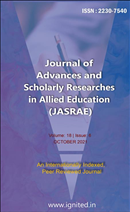An Analysis of Figurative Language on the Poem of William and Emily Dickinson
An Examination of Figurative Language in the Poems of Emily and William Dickinson
Keywords:
figurative language, literary components, poem, Emily Dickinson, William Dickinson, data collection, content analysis, metaphors, personification, alliteration, imagery, simile, symbolismAbstract
The incorporation of figurative language is a crucial aspect of the literary components thatcontribute to the comprehensive structure of a poem. The notion is conveyed with greater eloquence andclarity through nonverbal means. Figurative language is employed in both formal literary contexts and ineveryday communication. The primary focus of the researcher centres on Emily Dickinson's utilisation offigurative language and its correlation to the thematic content of her poetic works. William and EmilyDickinson are widely recognised as highly influential poets of their era, owing to their unique andfrequently unorthodox employment of language. The study's data collection process involved athoughtful consideration of the discrete categories of primary and secondary data. The assessment ofinformation requires the implementation of a content analysis, which entails a thorough examination ofthe textual environment of a literary work or manuscript. The objective of the present investigation is toanalyse the incidence of figurative language in a representative subset of 30 poems. The results suggestthat metaphors were the dominant form of figurative language utilised with a considerable degree offrequency. The research yielded four statistical results, among which 31 demonstrated that theaforementioned metaphorical device was the most widespread. The research findings revealed thatpersonification ranked as the second most prevalent form of figurative language, constituting 23 of alloccurrences. The following aspect pertains to the utilisation of alliteration and imagery, both of whichyielded analogous outcomes for two instances with a frequency of 15. The last classification pertainsto simile and symbolism, wherein only one occurrence was identified, constituting 8 of the entiredataset.Published
2021-10-01
How to Cite
[1]
“An Analysis of Figurative Language on the Poem of William and Emily Dickinson: An Examination of Figurative Language in the Poems of Emily and William Dickinson”, JASRAE, vol. 18, no. 6, pp. 458–462, Oct. 2021, Accessed: Jul. 02, 2024. [Online]. Available: https://ignited.in/jasrae/article/view/13585
Issue
Section
Articles
How to Cite
[1]
“An Analysis of Figurative Language on the Poem of William and Emily Dickinson: An Examination of Figurative Language in the Poems of Emily and William Dickinson”, JASRAE, vol. 18, no. 6, pp. 458–462, Oct. 2021, Accessed: Jul. 02, 2024. [Online]. Available: https://ignited.in/jasrae/article/view/13585








